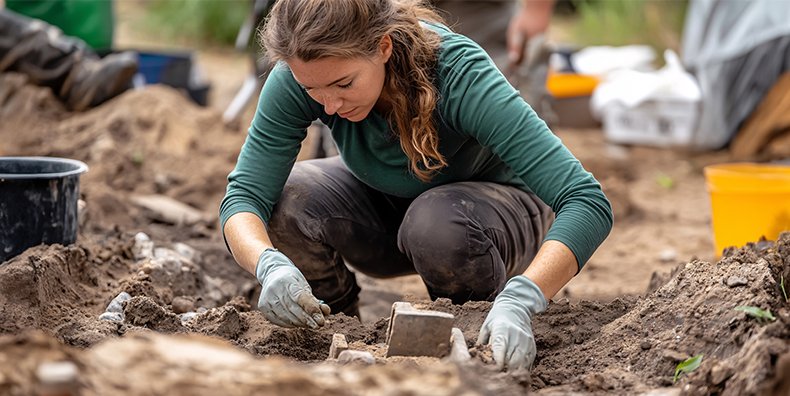Fieldwork in archaeology helped me understand emotional boundaries, pacing, and the layered process of living with bipolar disorder.
I never expected that brushing dirt off ancient artifacts would teach me how to care for my mental health.
When I began volunteering with an archaeologist, I thought I was simply following my passion for fieldwork. But what I discovered was something deeper: a surprising connection between archaeology and emotional healing.
What struck me most was how closely the excavation process mirrors the work of managing mental health — especially when it comes to pacing, patience, and knowing when to stop digging.
The Delicate Art of Digging
In archaeology, fieldwork involves using a trowel. There’s a specific way to hold it, a technique I had to learn properly before even attempting my first excavation. The archaeologist I worked with taught me a crucial lesson: there are dangers in digging too deep. Going too far too quickly could wreck the entire archaeological process. Hearing this, I immediately drew the connection between archaeology and mental health.
Just like in archaeology, digging too quickly into past experiences in therapy can be risky, especially without the right supports in place. Focusing too intensely on painful memories can sometimes worsen mental health challenges — something my NAMI support group gently reminds us to approach with care and in our own time.
Staying Grounded in the Now
There are also risks in looking too far ahead. Worrying about the future can easily pull us away from the present. In archaeology, focusing too much on what might lie beneath can cause experts to overlook what’s already in front of them. This oversight could result in missing important insights that can only be gained by carefully observing the clues an artifact provides now.
Similarly, with mental health, looking too far into the future carries the risk of obsessing over what hasn’t happened yet. It can also mean missing the simple joys of the present moment — those small, everyday events that bring us happiness.
What Archaeology Teaches Us About Emotions and Healing
One aspect of archaeology that fascinates me is how it reveals insights into past cultures. Artifacts give archaeologists clues about how ancient societies lived. But they also hint at previous human stories, struggles, and emotions — many remarkably similar to our own today.
As an archaeological volunteer, one of my greatest passions is uncovering these secrets that are hidden within artifacts, secrets only visible when you look closely enough. They are buried deep, and uncovering them requires knowledge of the cataloging process — the careful documentation and interpretation of each item’s context and details. To me, this mirrors the process of personal growth: confronting painful memories that are oftentimes locked away in the subconscious.
With each layer we uncover in ourselves, we invite healing. Just as artifacts gain new meaning when unearthed, so too can our memories — when revealed gently — help us better understand our own story.
Healing Happens in Layers, Just Like Excavation
Reflecting on layers, it’s striking how the hidden strata in artifacts mirror our mental health journeys. Like artifacts, our paths to wellness involve multiple layers. Healing is rarely a linear process; the struggle often involves intersecting experiences and memories.
Even progress, that sometimes loaded term, often happens in layers. While major breakthroughs can occur, they are often rare. More commonly, it’s the small changes — the slight, measurable signs that anxiety is easing — that accumulate over time.
Why Mental Health Progress Requires Patience and Pacing
Another crucial skill in archaeology is pacing. Digging too quickly can damage the site or cause you to miss artifacts altogether. Knowing when to step back, especially when tired or overwhelmed, is key to success.
This directly relates to mental health recovery. It’s important to know when to push yourself gently and when to allow yourself time to recover. Not confronting your fears at every single moment, for example, doesn’t mean failure; it simply means you’re giving your body and mind the necessary time to rest.
How Balance Supports Both Digging and Mental Health
In both archaeology and mental health recovery, there’s a significant need for balance. A lesson I’ve learned from archaeology is that while unearthing history is important, staying grounded in the moment allows archaeologists to make informed decisions about artifacts and how to use them to tell their stories.
Likewise, for our mental health journey, the present is where healing happens. Techniques such as grounding can help build resilience and enhance overall well-being.
During fieldwork, it’s common for some layers to remain hidden; even an excavated plot isn’t always fully unearthed. This serves as a reminder: In our mental health process, it’s okay to leave some painful memories untouched sometimes.
Emotional Boundaries and Knowing When to Stop Digging
It’s important to recognize our limits. In archaeology, there are times when digging must stop — whether to protect sacred land or to allow for future study.
In mental health, knowing when to pause is just as vital. Sometimes we need to step back and assess our boundaries. We may need to let go of a coping tool that no longer helps, or walk away from a situation that drains us. That isn’t failure — it’s wisdom. Giving ourselves permission to return to something later, or not at all, can be an act of self-protection.
Building healthy emotional boundaries — and honoring them — supports sustainable healing over the long term.
Honoring the Past While Living in the Present
One of archaeology’s greatest lessons is this: balance matters. To tell a meaningful story from the past, archaeologists must stay grounded in the present. The same is true in mental health.
As a future historian, I feel a strong pull to honor the past — but I also know the danger of becoming consumed by it. Instead, I try to let the past inform the present, and the present shape a better future.
There’s deep value in pausing to notice the everyday joys — a warm meal, a quiet moment, a safe space. These small moments are where healing happens.
So, if you’re doing your own emotional excavation, I hope this reflection reminds you to go gently. Trust the tools you’ve gathered. And just like an archaeologist with a trowel in hand, remember: you don’t have to unearth everything all at once to make meaningful progress.



